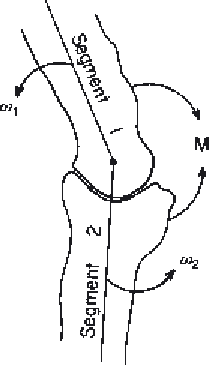Biomedical Engineering Reference
In-Depth Information
Figure 6.18
Energy transfer between segments occurs when both segments are rotat-
ing in the same direction and when there is a net moment of force acting across the
joint. See the text for a detailed discussion.
plus a transfer take place, while if
ω
1
<ω
2
, the muscles are shortening and a
generation as well as a transfer occur. Table 6.2, from Robertson and Winter
(1980), summarizes all possible power functions that can occur at a given
joint, and if we do not account for these energy transfers through the mus-
cles, we will not be able to account for the total power balance within each
segment. Thus, we must modify Equation (6.5) to include the angular veloc-
ities of the adjacent segments in order to partition the transfer component.
Therefore,
ω
j
is replaced by (
ω
1
−
ω
2
),
P
m
=
M
j
(ω
1
−
ω
2
)
W
(6.27)
Thus, if
ω
1
and
ω
2
have the same polarity, the rate of transfer will be the
lesser of the two power components. Examples are presented in Section 6.4.2
to demonstrate the calculation and to reinforce the sign convention used.
6.4.2 Power Balance Within Segments
Energy can enter or leave a segment at muscles and across joints at the
proximal and distal ends. Passive transfer across the joint [Equation (6.9)]
and active transfer plus absorption or generation [Equation (6.27)] must be
calculated. Consider Figure 6.19
a
as the state of a given segment at any given
point in time. The reaction forces and the velocities at the joint centers at the
proximal and distal ends are shown plus the moments of force acting at
the proximal and distal ends along with the segment angular velocity. The
total energy of the segment
E
s
as calculated by Equation (6.17) must also










Search WWH ::

Custom Search